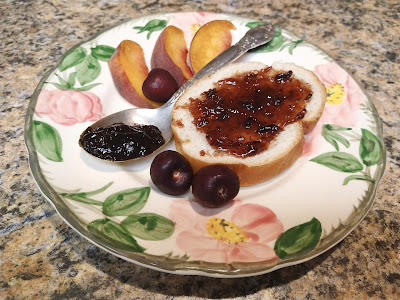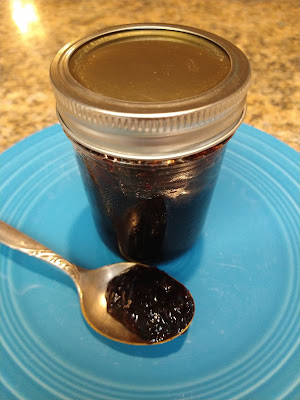
Recipe: Tutti frutti summer conserve is versatile condiment

|
“Conserve” lives up to its name. This age-old technique makes the most of summer’s sweet odds and ends, creating a jammy condiment as versatile and varied as its ingredients.
Tutti frutti – or “all fruits” – combines an array of summer favorites – fresh or frozen. For this batch, I used fresh peaches, Bing cherries and frozen Italian purple plums (remaining from last year’s crop).
By tradition, conserve uses at least two kinds of fruit, cooked with sugar. A green apple provides any necessary pectin. Raisins and, if desired, nuts are added to the mixture along with orange zest and juice. The nuts provide texture to go along with the sweet-tart fruit.
If used, wine smooths out the fruit flavors and also helps meld the colors. Red wine intensifies the purple.
Some conserves are intentionally chunky and best used as a dessert topping or alongside grilled or roast meats. Ingredients in this conserve are finely chopped, allowing the fruit mixture and raisins to cook down into an almost smooth jam. That consistency also works on desserts or next to meats, but is just at home on toast, bread or crackers. Team it with brie for an easy appetizer, too.
 |
|
The conserve can be frozen or water-bath
canned for later enjoyment.
|
Tutti frutti summer conserve
Makes about 3 half-pints (3 cups)
Ingredients:
Comments
0 comments have been posted.Sacramento Digs Gardening to your inbox.
Sites We Like
Garden Checklist for week of May 5
Survey your garden after the May 4 rainstorm. Heavy rain and gusty winds can break the neck of large flowers such as roses. Also:
* Keep an eye on new transplants or seedlings; they could take a pounding from the rain.
* Watch out for powdery mildew. Warmth following moist conditions can cause this fungal disease to “bloom,” too. If you see a leaf that looks like it’s dusted with powdered sugar, snip it off.
* After the storm, start setting out tomato transplants, but wait on the peppers and eggplants (they want warmer nights). Pinch off any flowers on new transplants to make them concentrate on establishing roots instead of setting premature fruit.
* Trim dead flowers but not leaves from spring-flowering bulbs such as daffodils and tulips. Those leaves gather energy to create next year's flowers. Also, give the bulbs a fertilizer boost after bloom.
* Pinch chrysanthemums back to 12 inches for fall flowers. Cut old stems to the ground.
* Mulch around plants to conserve moisture and control weeds.
* From seed, plant beans, beets, cantaloupes, carrots, corn, cucumbers, melons, pumpkins, radishes and squash.
* Plant onion sets.
* In the flower garden, plant seeds for asters, cosmos, celosia, marigolds, salvia, sunflowers and zinnias. Transplant petunias, zinnias, geraniums and other summer bloomers.
* Plant perennials and dahlia tubers for summer bloom.
* Don’t wait; plant summer bulbs, such as gladiolus and tuberous begonias.
* Harvest cabbage, lettuce, peas and green onions.